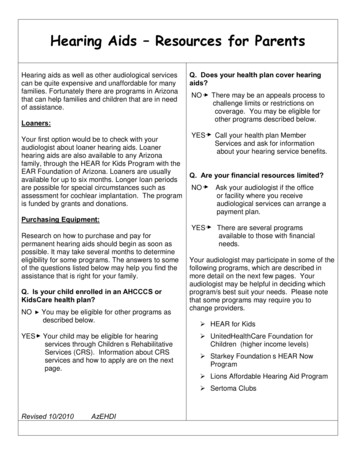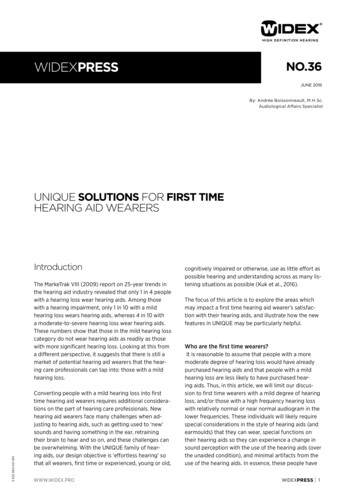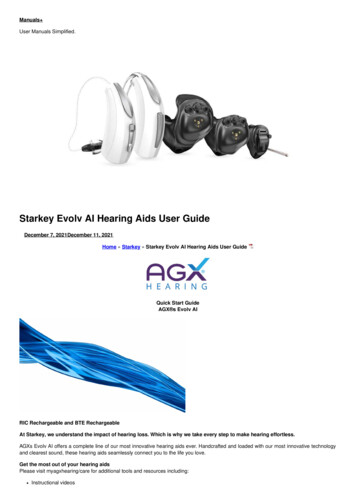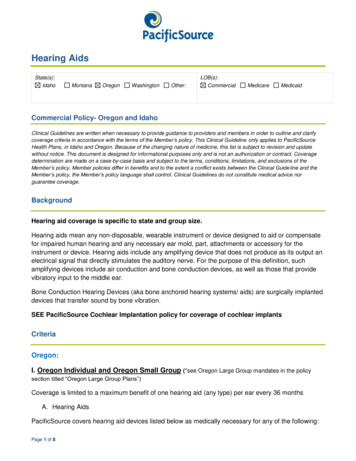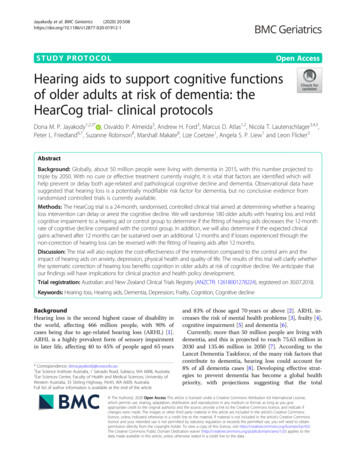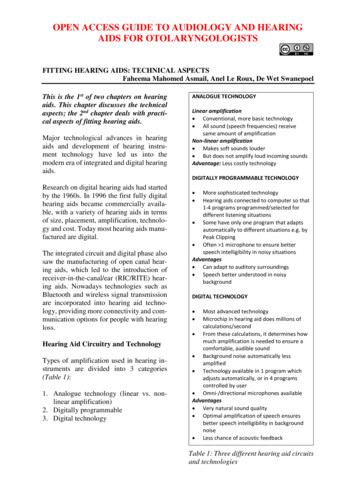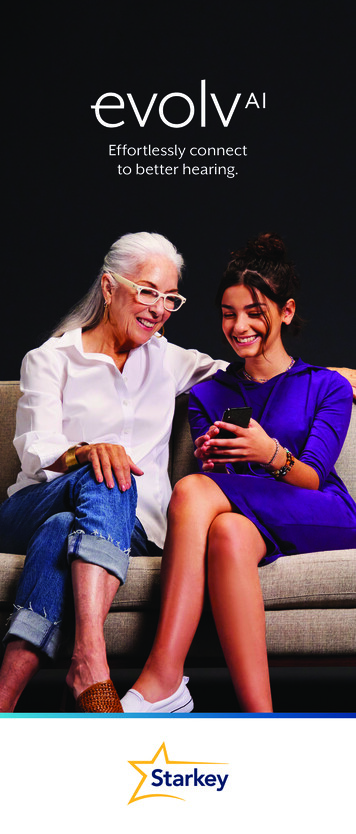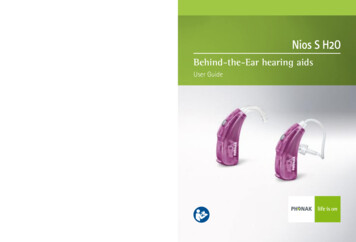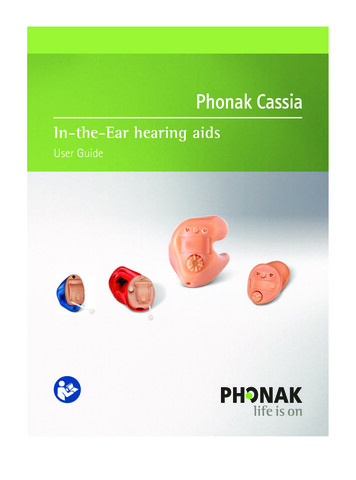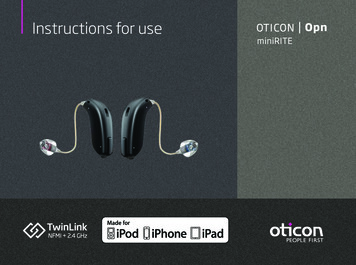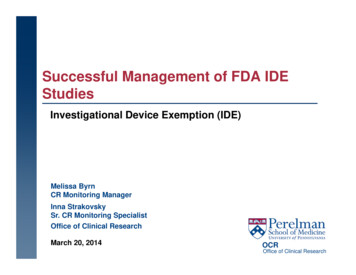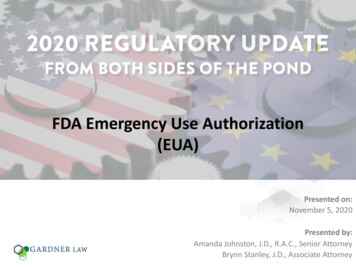
Transcription
FDA Regulation of Hearing AidsEric A. Mann, MD, PhDClinical Deputy DirectorDivision of Ophthalmic and ENT DevicesODE/CDRH/FDAFTC Workshop “Now Hear This”April 18, 2017
Presentation Outline Overview of risk-based regulatory approach for devices Hearing aid regulations Labeling Conditions for sale Recent developments PCAST, NASEM reports FDA Workshop: “Streamlining GMPs for Hearing Aids” Immediately in Effect Guidance re: medicalevaluation/waiver regulation Future Directionswww.fda.gov2
Definition of a Medical Device Intended to diagnose, cure, mitigate, treator prevent a disease/condition, or Intended to affect the structure orfunction of the body, and Does not achieve intended use throughchemical action or metabolismSec. 201, Food, Drug and Cosmetic Act3
Definition of Hearing AidHearing aid means any wearable instrument ordevice designed for, offered for the purpose of, orrepresented as aiding persons with or compensatingfor, impaired hearing.(21 CFR 801-420)4
Personal Sound AmplificationProducts (PSAPs) No formal regulatory definition PSAPs are intended to amplify environmental soundfor non-hearing impaired consumers for use in avariety of listening situations (e.g. hunting, birdwatching, listening to distant sounds) PSAPs do NOT meet the regulatory definition for amedical device and are not subject to medicaldevice regulations5
The Diversity of Medical Devices6
Regulatory Process for DevicesMedical Device Amendments of 1976 to the FD&C Act:Created a tiered, risk-based classification with regulatoryrequirements gauged to risks:ClassRiskRegulatory RequirementsClass ILowGeneral Controls (most exempt frommarketing application)Class IIModerateGeneral Controls and SpecialControlsClass IIIHighGeneral Controls and PremarketApproval (PMA)7
Regulatory Classification for HearingRelated DevicesClassRiskExampleClass ILowAir-conduction hearing aidClass IIMediumWireless air-conduction hearing aid (Class II exempt)Transcutaneous air-conduction hearing aidBone-conduction hearing aidBone-anchored hearing aidTinnitus maskerClass IIIHighCochlear implantImplantable middle ear hearing deviceAuditory brainstem implant8
21 CFR 874.3300 Hearing AidClass I: General Controls Prohibition of adulterated ormisbranded devices GMPs Registration ofmanufacturing facilities andlisting of device types Record keeping Repair, replacement, refund Premarket notification[510(k)]: most Class I devicesnow exempted9
21 CFR 874.3305 Wirelessair-conduction hearing aidClass II: General controls plus Special Controls Special Controls Appropriate analysis/testing shouldvalidate EMC and safety of exposure tononionizing radiation Design, description, and performance datashould validate wireless technologyfunctions Labeling should specify appropriateinstructions, warnings, and informationrelating to EMC and wireless technologyand human exposure to non-ionizingradiation Exempt from Premarket Notification10
Most air conduction hearing aids are not prescriptiondevices,BUT Hearing aids are restricted by regulation with respectto device labeling (21 CFR 801.420) and conditions forsale (21 CFR 801.421).11
Patient/Professional Labeling(21 CFR 801.420) User Instructional Brochure Instructions for use, expectations “Warning to Hearing Aid Dispensers”—red flag signs andsymptoms “Important Notice for Prospective Hearing Aid Users” Technical performance data (ANSI S3.22-2003)12
Hearing Aid Regulations (cont’d):Conditions for Sale (21 CFR 801.421) Medical evaluation by a licensed physician within thepreceding 6 months prior to dispensing Waiver of medical evaluation possible for users 18years Sign statement acknowledging that medical evaluation is inhis/her best health interest Dispenser may not actively encourage waiver Opportunity to review User Instructional Brochure Record keeping (3 years)13
Preamble to Hearing AidRegulations (1977)“The Commissioner emphasizes that the medicalevaluation requirement is based upon therecognition that an unnecessary or partially effectivehearing aid may be substituted for primary medicalor surgical treatment, thus depriving the patient of appropriate medical diagnosis and care resulting ina detriment to health.”14
Recent Developments President’s Council of Advisors on Science and Technology(PCAST) Report: “Aging America & Hearing Loss:Imperative of Improved Hearing Technologies” (October,2015) Recommendations for FDA included:– Create a new class of hearing aids for sale over-the-counter formild to moderate age-related hearing loss– Exempt this class of hearing aids from Quality Systems regulationin its present form and substitute compliance with standards forproduct quality and recordkeeping appropriate for the consumerelectronics industry– Rescind the 2013 draft hearing aid/PSAP guidance and allow PSAPsto make claims about their technological capabilities15
Recent Developments (cont’d) FDA public workshop: "Streamlining Good ManufacturingPractices (GMPs) for Hearing Aids” (April 21, 2016) Received comments/recommendations on:––––GMPs versus other quality/performance standardsFDA regulations and barriers to hearing aid accessConsumer perspectiveSelf-diagnosing and self-treating mild to moderate hearing loss16
Recent Developments (cont’d) National Academies of Sciences, Engineering, andMedicine (NASEM) Report: “Hearing Health Care forAdults: Priorities for Improving Access and Affordability”(June 2, 2016) Included recommendations for FDA:– Remove the medical evaluation/waiver requirement– Ensure consumers receive information about the medicalconditions of hearing loss through user instructional brochures– Establish a new category of over-the-counter (OTC) wearablehearing devices that can assist adults with mild to moderatehearing loss17
Recent Developments (cont’d) NASEM’s recommendations for FDA (cont’d):– Retain a guidance document (2009 or revised version of 2013guidance) on PSAPs clarifying that they are not to beoffered/promoted for hearing loss, but are subject to theelectronic product provisions of the Food, Drug, and Cosmetic Act18
Recent Developments (cont’d) “Immediately in Effect Guidance Document: Labeling andConditions for Sale for Non-Prescription Hearing Aids”(December 10, 2016)– FDA will not enforce medical evaluation/waiver requirement for 18 yr– Labeling regulation still enforced Senators Warren and Grassley introduced the “Over-theCounter Hearing Aid Act of 2017” to allow hearing aidsthat are intended to be used by adults to compensate formild to moderate hearing impairment to be sold over thecounter19
Future Directions Consider creating a category of OTC hearing aids that coulddeliver new, innovative and lower-cost products directly toconsumers without requirement for a credentialed dispenser Continue co-sponsorship of ongoing activities related to NASstudy– Solicit input from stakeholders on NAS recommendations regarding OTChearing aids: June 9, 2017 NAS Open Public Meeting Finalize guidance clarifying regulatory requirements for hearingaids vs. PSAPs20
Questions?Contact Information:Eric A. Mann, M.D., Ph.D.Clinical Deputy DirectorDONED/ODE/CDRHeric.mann@fda.hhs.gov(301) 796-646021
Conditions for Sale (21 CFR 801.421) Medical evaluation by a licensed physician within the preceding 6 months prior to dispensing Waiver of medical evaluation possible for users 18 years Sign statement acknowledging that medical evaluation is in his/her best health interest Dispenser may not actively encourage waiver
